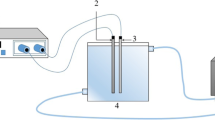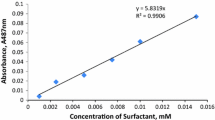Abstract
Objective
To develop a method to treat saline phenolic wastewater in a biological contact oxidation reactor (BCOR) with immobilized cells of a marine microorganism, Oceanimonas sp., isolated from seawater.
Results
Cells were immobilized on fibre carriers in the BCOR. Saline wastewater with phenol at 1.5 g/l and NaCl at 6 % (w/v) was treated. In continuous assays, 99 % removal of phenol was achieved and a kinetic model for the phenol degradation is presented based on Monod’s equation.
Conclusion
The BOCR system using immobilized cells of Oceanimonas efficiently treats saline phenolic wastewaters without having decrease the salinity of the wastewater.





Similar content being viewed by others
Abbreviations
- A :
-
Specific surface area of carriers (m2/m3)
- D :
-
Thickness of microbial system on carriers (m)
- \( \left( {\frac{dS}{dt}} \right)_{A} \) :
-
Removal rate of phenol by microorganisms loaded on carriers (mg/l h)
- \( \left( {\frac{dS}{dt}} \right)_{s} \) :
-
Removal rate of phenol by microorganisms suspended in the bioreactor (mg/l h)
- K s :
-
Saturation constant (mg/l, equal to the concentration of phenol when \( \mu = \frac{{\mu_{max} }}{2} \))
- \( N \) :
-
Volume of carriers (l)
- Q :
-
Quantity of influent flow (m3/d)
- S :
-
Concentration of phenol (mg/l)
- S o :
-
Concentration of phenol in the influent (mg/l)
- S e :
-
Concentration of phenol in the effluent (mg/l)
- U:
-
Removal rate of phenol per area of carriers (g/m2 d)
- V A :
-
Volume of microbial system loaded on carriers (m3)
- V S :
-
Volume of whole solution in the bioreactor (m3)
- X A :
-
Mass of immobilized microorganisms (mg/l)
- Y A :
-
Yield (%)
- μ :
-
Specific growth rate (h−1)
- μ max :
-
Maximum specific growth rate (h−1)
References
Arutchelvan V, Kanakasabai V, Elangovan R, Nagarajan S, Muralikrishnan V (2006) Kinetics of high strength phenol degradation using Bacillus brevis. J Hazard Mater 129:216–222
Bastos AER, Moon DH, Rossi A, Trevors JT, Tsai SM (2000) Salt-tolerant phenol-degrading microorganisms isolated from Amazonian soil samples. Arch Microbiol 174:346–352
Bonfa MRL, Grossman MJ, Piubeli F, Mellado E, Durrant LR (2013) Phenol degradation by halophilic bacteria isolated from hypersaline environments. Biodegradation 24:699–709
Chinese-SEPA (1997) Water and wastewater monitoring methods, 3rd edn. Chinese Environmental Science Publishing House, Beijing
Fernandez-Torres MJ, Randall DG, Melamu R, von Blottnitz H (2012) A comparative life cycle assessment of eutectic freeze crystallisation and evaporative crystallisation for the treatment of saline wastewater. Desalination 306:17–23
Jiang Y, Shang Y, Yang K, Wang HY (2016) Phenol degradation by halophilic fungal isolate JS4 and evaluation of its tolerance of heavy metals. Appl Microbiol Biotechnol 100:1883–1890
Kargi F, Dincer AR (1996) Effect of salt concentration on biological treatment of saline wastewater by fed-batch operation. Enzyme Microb Technol 19:529–537
Kargi F, Dincer AR (1999) Salt inhibition effects in biological treatment of saline wastewater in RBC. J Environ Eng 125:966–997
Kim Y, Logan BE (2013) Simultaneous removal of organic matter and salt ions from saline wastewater in bioelectrochemical systems. Desalination 308:115–121
Kim SB, Seong CN, Jeon SJ, Bae KS, Goodfellow M (2004) Taxonomic study of neutrotolerant acidophilic actinomycetes isolated from soil and description of Streptomyces yeochonensis sp. nov. Int J Syst Evol Microbiol 54:211–214
Lee TH, Kurata S, Nakatsu CH, Kamagata Y (2005) Molecular analysis of bacterial community based on 16S rDNA and functional genes in activated sludge enriched with 2,4-dichlorophenoxyacetic acid (2,4-D) under different cultural conditions. Microb Ecol 49:151–162
Lefebvre O, Moletta R (2006) Treatment of organic pollution in industrial saline wastewater: a literature review. Water Res 40:3671–3682
Li WG, Tan SW, Xu Z, Yang HR, Wei L, Su JF, Ma F (2012) Alkalibacillus huanghaiensis sp. nov., a new strain of moderately halophilic bacterias isolated from sea water of the Yellow Sea in China. Adv Mater Res 518–523:8–15
Lu J, Yan X, Ma YF, Tian CX, Ding JC (2014) Impact of salinity on treatment of saline wastewater by sequencing batch biofilm reactor process. J Cent South Univ 21:1989–1994
Moxley K, Schmidt S (2012) Isolation of a phenol-utilizing marine bacterium from Durban Harbour (South Africa) and its preliminary characterization as Marinobacter sp. KM2. Water Sci Technol 65:932–939
Oren A (2008) Microbial life at high salt concentrations: phylogenetic and metabolic diversity. Saline Syst 4:2
Panswad T, Anan C (1999) Impact of high chloride wastewater on an anaerobic/anoxic/aerobic process with and without inoculation of chloride acclimated seeds. Water Res 33:1165–1172
Peyton BM, Wilson T, Yonge DR (2002) Kinetics of phenol biodegradation in high salt solutions. Water Res 36:4811–4820
Taheri E, Khiadani MH, Amin MM, Nikaeen M, Hassanzadeh A (2012) Treatment of saline wastewater by a sequencing batch reactor with emphasis on aerobic granule formation. Bioresour Technol 111:21–26
Wagner M, Loy A, Nogueira R, Purkhold U, Lee N, Daims H (2002) Microbial community composition and function in wastewater treatment plants. Antonie Van Leeuwenhoek 81:665–680
Yi H, Chun J (2004) Hongiella mannitolivorans gen. nov., sp. nov., Hongiella halophila sp. nov. and Hongiella ornithinivorans sp. nov., isolated from tidal flat sediment. Int J Syst Evol Microbiol 54:157–162
Yoshie S, Makino H, Hirosawa H, Shirotani K, Tsuneda S, Hirata A (2006) Molecular analysis of halophilic bacterial community for high-rate denitrification of saline industrial wastewater. Appl Microbiol Biotechnol 72:182–189
Yuan RX, Wang ZH, Hu Y, Wang BH, Gao SM (2014) Probing the radical chemistry in UV/persulfate-based saline wastewater treatment: kinetics modeling and byproducts identification. Chemosphere 109:106–112
Acknowledgments
This work is funded by China Scholarship Council and Harbin Institute of Technology (Weihai) (Ref. No. HIT(WH)XB200804). Our gratitude also goes to the staff in the Department of Chemical and Biomolecular Engineering, University of Sydney and the Departments of Environmental Engineering, Harbin Institute of Technology (Weihai) for their very kind assistance.
Supporting information
Isolation and identification of the marine microorganism.
Author information
Authors and Affiliations
Corresponding author
Electronic supplementary material
Below is the link to the electronic supplementary material.
Rights and permissions
About this article
Cite this article
Tan, S., Chen, X., Cui, C. et al. Biodegradation of saline phenolic wastewater in a biological contact oxidation reactor with immobilized cells of Oceanimonas sp.. Biotechnol Lett 39, 91–96 (2017). https://doi.org/10.1007/s10529-016-2226-9
Received:
Accepted:
Published:
Issue Date:
DOI: https://doi.org/10.1007/s10529-016-2226-9




